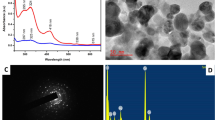Abstract
A new neurotoxin RTX-VI that modulates the voltage-gated sodium channels (NaV) was isolated from the ethanolic extract of the sea anemone Heteractis crispa. Its amino acid sequence was determined using the combination of Edman degradation and tandem mass spectrometry. RTX-VI turned out to be an unusual natural analogue of the previously described sea anemone toxin RTX-III. The RTX-VI molecule consists of two disulfide-linked peptide chains and is devoid of Arg13, which is important for the selectivity and affinity of such peptides for the NaV channels. Electrophysiological screening of RTV-VI on NaV channel subtypes showed its selective interaction with the central nervous system (NaV1.2, NaV1.6) and insect (BgNaV1, VdNaV1) sodium channels.



Similar content being viewed by others
REFERENCES
Deuis, J., Mueller, A., Israel, M., et al., The pharmacology of voltage-gated sodium channel activators, Neuropharmacology, 2017, vol. 127, pp. 87–108. https://doi.org/10.1016/j.neuropharm.2017.04.0
Sintsova, O., Gladkikh, I., Chausova, V., et al., Peptide fingerprinting of the sea anemone Heteractis magnifica mucus revealed neurotoxins, Kunitz-type proteinase inhibitors and a β-defensin α-amylase inhibitor, J. Proteomics, 2017, vol. 173, pp. 12–21. https://doi.org/10.1016/j.jprot.2017.11.019
Frazão, B., Vasconcelos, V., and Antunes, A., Sea anemone (Cnidaria, Anthozoa, Actiniaria) toxins: an overview, Mar. Drugs, 2012, vol. 10, no. 12, pp. 1812–1851. https://doi.org/10.3390/md10081812
Kalina, R., Gladkikh, I., Dmitrenok, P., et al., New APETx-like peptides from sea anemone Heteractis crispa modulate ASIC1a channels, Peptides, 2018, vol. 104, pp. 41–49. https://doi.org/10.1016/j.peptides.2018.04.013
Rauer, H., Pennington, M., Cahalan, M., et al., Structural conservation of the pores of calcium-activated and voltage-gated potassium channels determined by a sea anemone toxin, J. Biol. Chem., 1999, vol. 274, no. 31, pp. 21885–21892. https://doi.org/10.1074/jbc.274.31.21885
Monastyrnaya, M., Peigneur, S., Zelepuga, E., et al., Kunitz-type peptide HCRG21 from the sea anemone Heteractis crispa is a full antagonist of the TRPV1 receptor, Mar. Drugs, 2016, vol. 14, no. 12, p. 229. https://doi.org/10.3390/md14120229
Logashina, Y.A., Mosharova, I.V., Korolkova, Y.V., et al., Peptide from sea anemone Metridium senile affects transient receptor potential ankyrin-repeat 1 (TRPA1) function and produces analgesic effect, J. Biol. Chem., 2017, vol. 292, no. 7, pp. 2992–3004. https://doi.org/10.1074/jbc.M116.757369
Schweitz, H., Bidard, J., Frelin, C., et al., Purification, sequence, and pharmacological properties of sea anemone toxins from Radianthus paumotensis. A new class of sea anemone toxins acting on the sodium channel, Biochemistry, 1985, vol. 24, no. 14, pp. 3554–3561. https://doi.org/10.1021/bi00335a025
Salgado, V.L. and Kem, W.R., Actions of three structurally distinct sea anemone toxins on crustacean and insect sodium channels, Toxicon, 1992, vol. 30, no. 11, pp. 1365–1381. https://doi.org/10.1016/0041-0101(92)90512-4
Honma, T., Kawahata, S., Ishida, M., et al., Novel peptide toxins from the sea anemone Stichodactyla haddoni, Peptides, 2008, vol. 29, no. 4, pp. 536–544. https://doi.org/10.1016/j.peptides.2007.12.010
Zykova, T.A., Vinokurov, L.M., Kozlovskaya, E.P., et al., Amino acid sequence of neurotoxin III from the sea anemone Radianthus macrodactylus, Bioorg. Khim., 1985, vol. 11, no. 3, pp. 302–310.
Wilcox, G.R., Fogh, R.H., and Norton, R.S., Refined structure in solution of the sea anemone neurotoxin ShI, J. Biol. Chem., 1993, vol. 268, no. 33, pp. 24707–24719.
Pallaghy, P.K., Scanlon, M., Monks, S., et al., Three-dimensional structure in solution of the polypeptide cardiac stimulant anthopleurin-A, Biochemistry, 1995, vol. 34, no. 11, pp. 3782–3794. https://doi.org/10.1021/bi00011a036
Wullschleger, B., Kuhn-Nentwig, L., Tromp, J., et al., CSTX-13, a highly synergistically acting two-chain neurotoxic enhancer in the venom of the spider Cupiennius salei (Ctenidae), Proc. Natl. Acad. Sci. U. S. A., 2004, vol. 101, no. 31, pp. 11251–11256. https://doi.org/10.1073/pnas.0402226101
ACKNOWLEDGMENTS
The study was carried out on the equipment of the Collective Facilities Center “The Far Eastern Center for Structural Molecular Research (NMR/MS) PIBOC FEB RAS.”
Funding
This work was supported by the Russian Foundation for Basic Research (grant no. 18-04-00631).
Author information
Authors and Affiliations
Corresponding author
Ethics declarations
Conflict of interest. The authors declare that the studies were conducted in the absence of any commercial or financial relationship that could be construed as a potential conflict of interest.
Statement on the welfare of animals. All applicable international, national, and/or institutional guidelines for the care and use of animals were followed.
Additional information
Translated by M. Batrukova
Rights and permissions
About this article
Cite this article
Kalina, R.S., Peigneur, S., Gladkikh, I.N. et al. New Sea Anemone Toxin RTX-VI Selectively Modulates Voltage-Gated Sodium Channels. Dokl Biochem Biophys 495, 292–295 (2020). https://doi.org/10.1134/S1607672920060071
Received:
Revised:
Accepted:
Published:
Issue Date:
DOI: https://doi.org/10.1134/S1607672920060071




